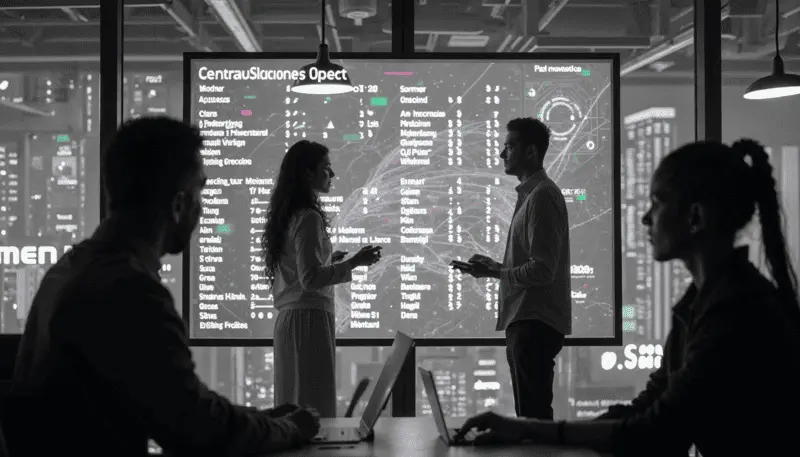Risk management is critical for businesses in every industry, from finance to healthcare to manufacturing. Traditionally, risk management has relied on human expertise, data analysis, and historical insights to predict and mitigate risks. But with the rise of Artificial Intelligence (AI), the game has changed. AI is now playing a key role in helping organizations identify, assess, and reduce risks more efficiently and accurately than ever before.
In this blog, we’ll explore how AI is transforming risk management, the benefits it brings, and real-world examples of AI being used to protect businesses and improve decision-making.
1. AI for Predictive Risk Analysis
One of the biggest strengths of AI is its ability to process and analyze large volumes of data. When it comes to risk management, AI-powered systems can sift through historical data, market trends, and even real-time events to predict potential risks.
How It Works:
- Machine learning algorithms analyze past data to identify patterns that may indicate future risks, such as economic downturns, cybersecurity threats, or operational failures.
- AI can monitor real-time data (such as social media, news outlets, or market prices) to provide early warnings of emerging risks that may impact a company.
Real-World Example:
In the finance industry, AI is used to predict market risks by analyzing millions of transactions and financial data points. AI can flag unusual patterns that could indicate market instability or investment risks, helping traders make informed decisions faster.
2. Fraud Detection and Prevention
One of the most powerful uses of AI in risk management is fraud detection. AI systems can monitor transactions and user behaviors in real-time to detect suspicious activities that may indicate fraud. Traditional methods of fraud detection often rely on predefined rules, but AI takes it a step further by continuously learning and adapting to new fraud tactics.
How It Works:
- AI algorithms use historical data to learn the difference between normal and suspicious behavior. It can analyze transaction patterns, account activity, and other data points to spot anomalies that could signal fraud.
- Anomaly detection tools powered by AI are able to monitor thousands of transactions simultaneously and flag those that deviate from normal patterns.
Real-World Example:
Banks and credit card companies use AI-based fraud detection systems to spot suspicious transactions in real-time. For instance, AI can detect if a user’s credit card is being used in an unusual location or in a manner inconsistent with their usual spending habits, triggering alerts and blocking the transaction if necessary.
3. AI for Cybersecurity Risk Management
With cyberattacks on the rise, AI is becoming an essential tool for cybersecurity risk management. AI can continuously scan systems, networks, and databases to identify potential vulnerabilities and threats before they lead to a breach.
How It Works:
- AI-powered security systems can analyze network traffic, monitor user behavior, and detect unusual patterns that may indicate a cyberattack, such as phishing attempts, malware, or unauthorized access.
- AI can predict potential vulnerabilities by analyzing how similar organizations have been targeted in the past, allowing companies to strengthen their defenses proactively.
Real-World Example:
AI-driven cybersecurity platforms like Darktrace use machine learning to identify and neutralize threats in real time. The AI system learns what normal network behavior looks like, then uses this knowledge to flag suspicious activities before they escalate into major security breaches.
4. Supply Chain Risk Management with AI
Managing risks in a global supply chain is a complex challenge. AI helps companies predict and mitigate risks related to supplier disruptions, demand fluctuations, and logistical challenges by analyzing vast amounts of data in real-time.
How It Works:
- AI can monitor external data sources such as weather conditions, geopolitical events, and supplier performance metrics to predict supply chain disruptions before they happen.
- AI-driven analytics help companies optimize inventory levels, predict delays, and adjust procurement strategies to reduce the impact of risks.
Real-World Example:
Companies like Amazon and Walmart use AI to monitor their global supply chains. AI systems track real-time data to predict delays, shortages, or transportation issues. This allows businesses to take corrective action, such as sourcing from alternate suppliers or adjusting delivery schedules.
5. Risk Scoring and Assessment
AI is revolutionizing the way companies assess and score risk. Rather than relying solely on human judgment or historical data, AI systems use machine learning models to assign dynamic risk scores to various business activities or transactions. These scores are continuously updated based on new data, giving companies a real-time understanding of potential risks.
How It Works:
- AI systems evaluate a wide range of factors—such as financial health, market conditions, and operational data—to assign risk scores. These scores help businesses prioritize which risks need immediate attention.
- Continuous monitoring means risk scores can change as new information comes in, allowing companies to respond quickly to evolving risks.
Real-World Example:
In insurance, AI is used to assess the risk of issuing a policy by analyzing customer behavior, health records, and market trends. This enables insurers to price policies more accurately and reduce the likelihood of underwriting bad risks.
6. AI in Regulatory Compliance and Risk Management
For industries heavily regulated, such as finance and healthcare, ensuring compliance with government regulations is critical. AI helps businesses stay compliant by automating the monitoring of legal requirements, identifying potential compliance risks, and alerting managers when corrective actions are needed.
How It Works:
- AI-powered compliance tools scan documents, contracts, and internal records to ensure they meet regulatory requirements.
- AI can monitor regulatory changes in real-time and notify organizations of any new rules that might impact their operations, reducing the risk of non-compliance.
Real-World Example:
Banks use AI to help monitor compliance with anti-money laundering (AML) and know your customer (KYC)regulations. AI systems can automatically flag suspicious transactions or behavior that violates compliance rules, reducing the risk of regulatory penalties.
7. AI for Operational Risk Management
Operational risks arise from internal processes, people, or systems within a business. AI can help organizations identify, analyze, and mitigate operational risks more effectively by providing real-time insights into how various operations are performing.
How It Works:
- AI systems can monitor day-to-day business processes, flagging inefficiencies, or errors that could lead to operational risks. This includes tracking performance metrics, employee behaviors, or machine outputs.
- By using predictive analytics, AI can warn organizations of potential breakdowns or disruptions in their operations, allowing for timely preventive measures.
Real-World Example:
Manufacturing companies use AI to monitor machinery and production lines. AI can predict when a machine is likely to fail based on usage data, allowing the company to schedule maintenance before a breakdown occurs, reducing downtime and operational risk.
Final Thoughts: AI Is Revolutionizing Risk Management
Artificial Intelligence is becoming a crucial tool in risk management, providing businesses with faster, more accurate insights into potential threats. From predictive risk analysis and fraud detection to cybersecurity and supply chain management, AI is helping companies stay ahead of risks and make more informed decisions.
By adopting AI, businesses can not only minimize risks but also take advantage of new opportunities for growth and innovation. As AI technology continues to evolve, it will play an even larger role in helping organizations manage complex risks in an increasingly unpredictable world.
Looking to integrate AI into your risk management strategy? Contact us for expert insights on how AI can help your business stay protected and proactive in a rapidly changing environment.





